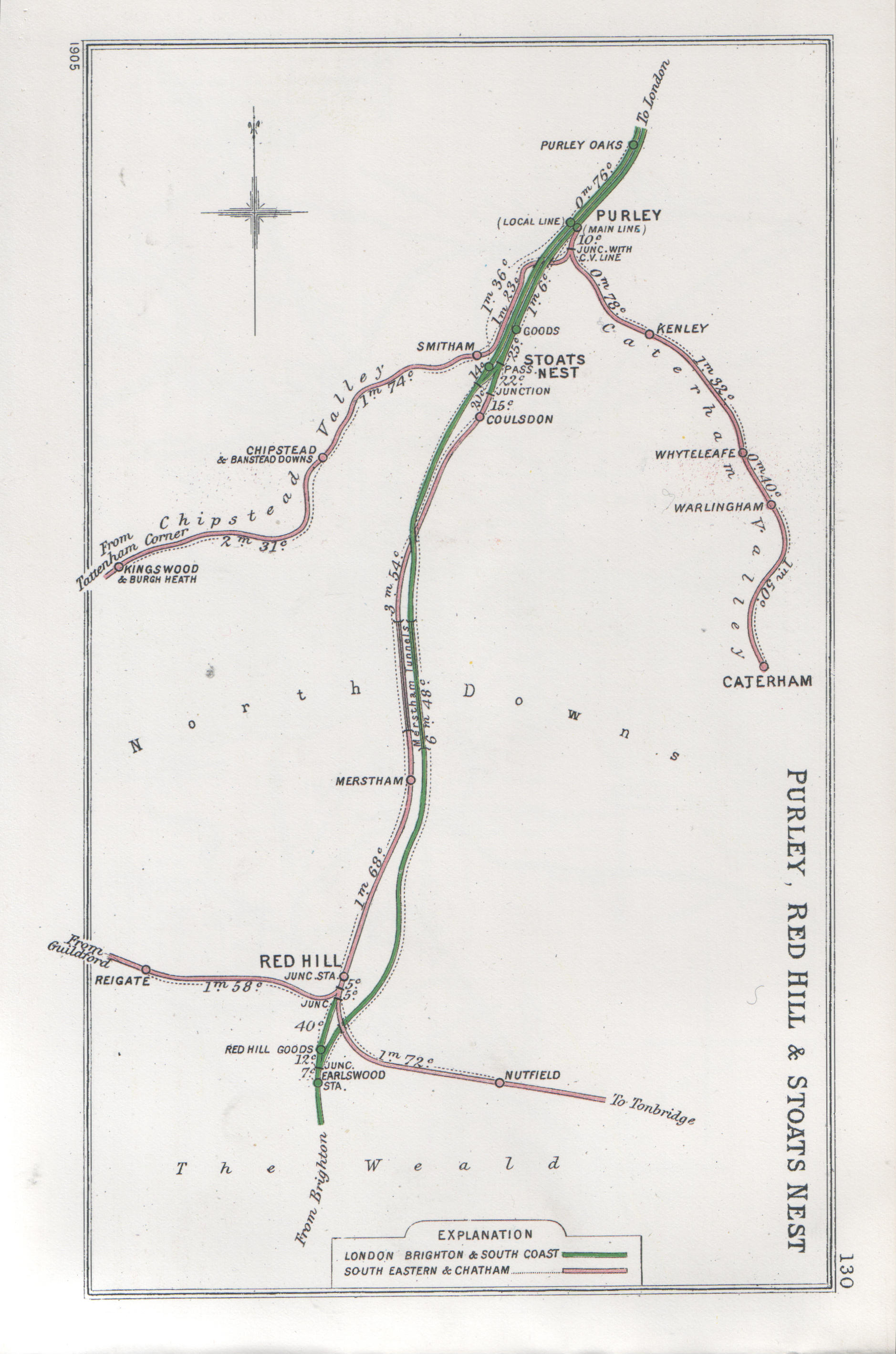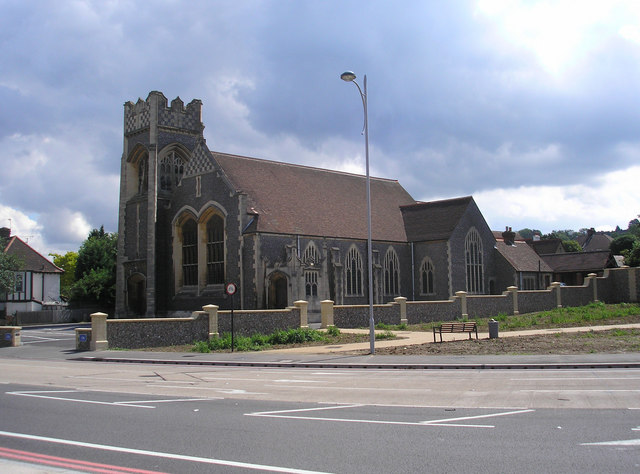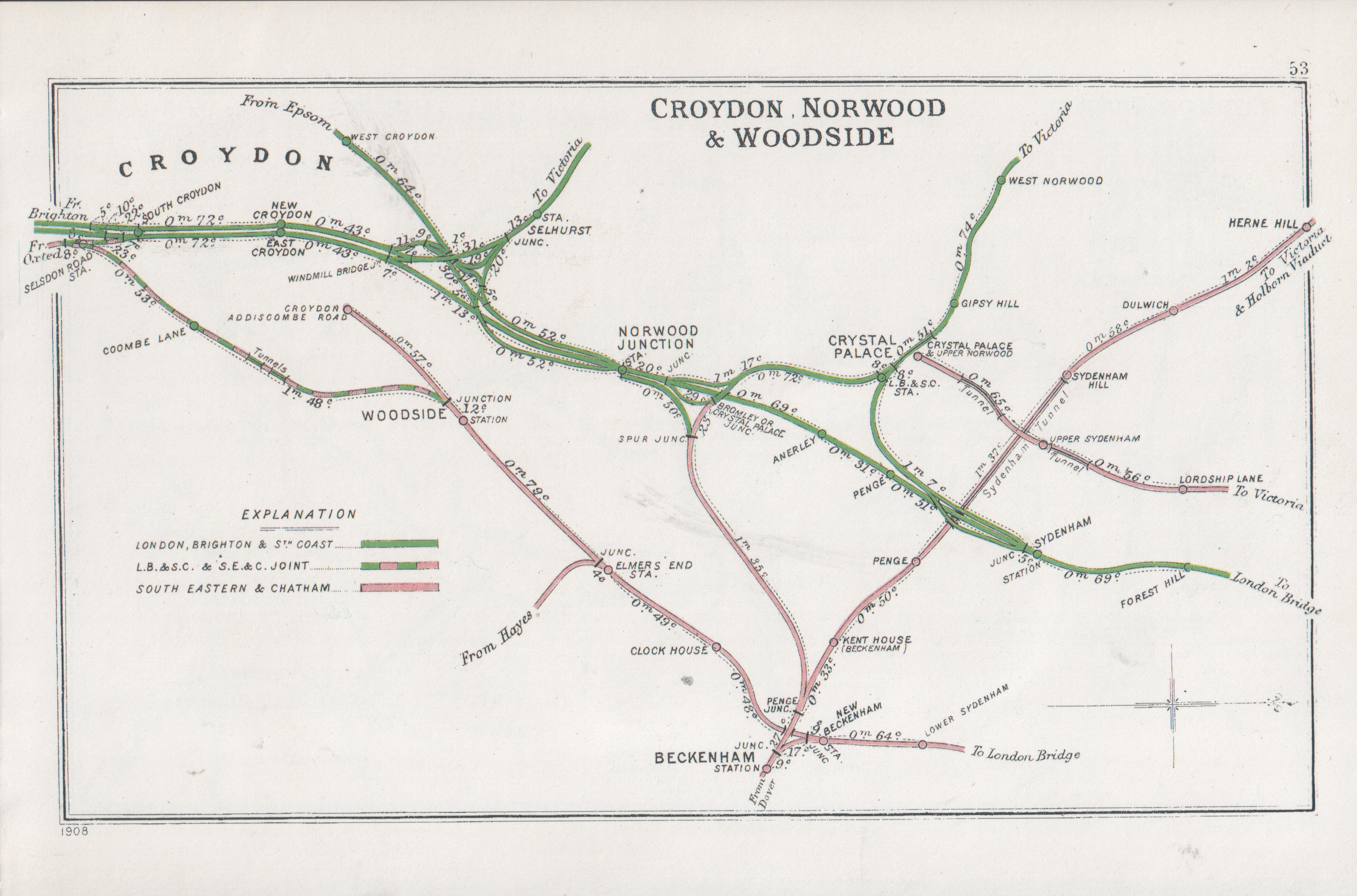|
Coulsdon North Railway Station
Coulsdon North is a closed railway station that served Coulsdon, Croydon, England, on the Brighton Main Line. Stoat's Nest The first station in Coulsdon was opened by the London and Brighton Railway on 12 July 1841, named after a nearby settlement. It stood approximately at the junction of present-day Windermere Road and Stoat's Nest Road. Nothing remains of this station today. It was one mile south of Godstone Road station (later called Caterham Junction and then Purley), and was the first station to serve Epsom Downs Racecourse, some eight miles (13 km) distant. It was in service until December 1856, when Godstone Road station reopened and the L&BR successor, the London Brighton and South Coast Railway (LB&SCR) had its own route from Croydon to Epsom. Opening The station was opened as "Stoats Nest and Cane Hill" on 5 November 1899 by the London, Brighton and South Coast Railway (LBSCR). It took its name partly from the nearby Cane Hill asylum and partly from th ... [...More Info...] [...Related Items...] OR: [Wikipedia] [Google] [Baidu] |
Coulsdon
Coulsdon (, traditionally pronounced ) is a town in south London, England, within the London Borough of Croydon, in the ceremonial county of Greater London since 1965. Prior to this it was part of the historic county of Surrey. History The location forms part of the North Downs. The hills contain chalk and flint. A few dry valleys with natural underground drainage merge and connect to the main headwater of the River Wandle, as a winterbourne (stream), so commonly called "the Bourne". Although this breaks onto the level of a few streets when the water table is exceptionally high, the soil is generally dry. The depression and wind gap has been a natural route way across the Downs for early populations. Fossil records exist from the Pleistocene period (about 4,000,000 years ago) There is evidence of human occupation from the Neolithic period, Iron Age,Volume 9 of the Bourne Society's Local History Records (1970) Anglo-Saxon, Bronze Age, Roman and Medieval *675. Frithwald ... [...More Info...] [...Related Items...] OR: [Wikipedia] [Google] [Baidu] |
Coulsdon South Railway Station
Coulsdon South railway station serves Coulsdon in the London Borough of Croydon, and is in Travelcard Zone 6, on the Brighton Main Line. It is measured from . The station is served by Southern and by ThamesLink. It is the mouth southerly mainline station in London. History Coulsdon is on a stretch of line between Croydon and Redhill which the UK Parliament insisted should be shared by the London and Brighton Railway (L&BR) route to Brighton, and the South Eastern Railway (SER) route to Dover. As a result, there have been a number of railway stations at Coulsdon. Coulsdon South This station was opened by the South Eastern Railway (SER) on 1 October 1889. The line is on a steep gradient climbing towards Merstham Tunnel. It is from , and has two platforms each long enough for a 12-coach train. It was originally called Coulsdon and Cane Hill, referring to the nearby psychiatric hospital: a covered way connected the station to the hospital. By the 1960s, the covered w ... [...More Info...] [...Related Items...] OR: [Wikipedia] [Google] [Baidu] |
East Croydon Railway Station
East Croydon is a railway station and tram stop in Croydon, Greater London, England, and is located in Travelcard Zone 5. At from , it is one of the busiest non-terminal stations in London, and in the United Kingdom as a whole. It is one of three railway stations in the London Borough of Croydon with Croydon in their name, the others being West Croydon railway station, West Croydon and South Croydon railway station, South Croydon. A Tramlink tram stop is located immediately outside the main station entrance. The present station building opened on 19 August 1992. It consists of a large steel and glass frame suspended from a lightweight steel structure that straddles the track and platforms to a much greater extent than was possible with its Victorian era, Victorian predecessor. Four steel Mast radiator, ladder masts anchor the glass box and the whole gives the impression of a suspension bridge that stretches into the distance. External canopy (building), canopies cover the entra ... [...More Info...] [...Related Items...] OR: [Wikipedia] [Google] [Baidu] |
Coulsdon North Railway Station 3
Coulsdon (, traditionally pronounced ) is a town in south London, England, within the London Borough of Croydon, in the ceremonial county of Greater London since 1965. Prior to this it was part of the historic county of Surrey. History The location forms part of the North Downs. The hills contain chalk and flint. A few dry valleys with natural underground drainage merge and connect to the main headwater of the River Wandle, as a winterbourne (stream), so commonly called "the Bourne". Although this breaks onto the level of a few streets when the water table is exceptionally high, the soil is generally dry. The depression and wind gap has been a natural route way across the Downs for early populations. Fossil records exist from the Pleistocene period (about 4,000,000 years ago) There is evidence of human occupation from the Neolithic period, Iron Age,Volume 9 of the Bourne Society's Local History Records (1970) Anglo-Saxon, Bronze Age, Roman and Medieval *675. Frithwald, an Ea ... [...More Info...] [...Related Items...] OR: [Wikipedia] [Google] [Baidu] |
Coulsdon Town Railway Station
Coulsdon Town railway station serves the northern part of Coulsdon, in the London Borough of Croydon. It is on the Tattenham Corner line from and opened on 1 January 1904. Until 22 May 2011 it was called Smitham. History The station was opened as ''Smitham'' on 1 January 1904, and was briefly closed (between 1 January 1917 and 1 January 1919) during the First World War. It lies on a sharp curve, where the line swings away westwards from the Brighton Main Line. It is immediately adjacent to the closed Coulsdon North station on the main line, whose passenger traffic was diverted here when the latter closed on 3 October 1983. Some Tattenham Corner line trains terminated at Smitham before returning to London, but nowadays the usual off-peak service is two trains per hour in each direction between London Bridge and Tattenham Corner. An hourly shuttle service used to be in operation during weekday off-peak hours between Purley and Tattenham Corner, but this was withdrawn in ... [...More Info...] [...Related Items...] OR: [Wikipedia] [Google] [Baidu] |
Coulsdon North Railway Station 2
Coulsdon (, traditionally pronounced ) is a town in south London, England, within the London Borough of Croydon, in the ceremonial county of Greater London since 1965. Prior to this it was part of the historic county of Surrey. History The location forms part of the North Downs. The hills contain chalk and flint. A few dry valleys with natural underground drainage merge and connect to the main headwater of the River Wandle, as a winterbourne (stream), so commonly called "the Bourne". Although this breaks onto the level of a few streets when the water table is exceptionally high, the soil is generally dry. The depression and wind gap has been a natural route way across the Downs for early populations. Fossil records exist from the Pleistocene period (about 4,000,000 years ago) There is evidence of human occupation from the Neolithic period, Iron Age,Volume 9 of the Bourne Society's Local History Records (1970) Anglo-Saxon, Bronze Age, Roman and Medieval *675. Frithwald, an Ea ... [...More Info...] [...Related Items...] OR: [Wikipedia] [Google] [Baidu] |
Third Rail
A third rail, also known as a live rail, electric rail or conductor rail, is a method of providing electric power to a railway locomotive or train, through a semi-continuous rigid conductor placed alongside or between the rails of a railway track. It is used typically in a mass transit or rapid transit system, which has alignments in its own corridors, fully or almost fully segregated from the outside environment. Third rail systems are usually supplied from direct current electricity. Modern tram systems, street-running, avoid the risk of electrocution by the exposed electric rail by implementing a segmented ground-level power supply, where each segment is electrified only while covered by a vehicle which is using its power. The third-rail system of electrification is not related to the third rail used in dual gauge railways. Description Third-rail systems are a means of providing electric traction power to trains using an additional rail (called a "conductor rail") ... [...More Info...] [...Related Items...] OR: [Wikipedia] [Google] [Baidu] |
London And South Western Railway
The London and South Western Railway (LSWR, sometimes written L&SWR) was a railway company in England from 1838 to 1922. Originating as the London and Southampton Railway, its network extended to Dorchester and Weymouth, to Salisbury, Exeter and Plymouth, and to Padstow, Ilfracombe and Bude. It developed a network of routes in Hampshire, Surrey and Berkshire, including Portsmouth and Reading. The LSWR became famous for its express passenger trains to Bournemouth and Weymouth, and to Devon and Cornwall. Nearer London it developed a dense suburban network and was pioneering in the introduction of a widespread suburban electrified passenger network. It was the prime mover of the development of Southampton Docks, which became an important ocean terminal as well as a harbour for cross channel services and for Isle of Wight ferries. Although the LSWR's area of influence was not the home of large-scale heavy industry, the transport goods and mineral traffic was a major activity ... [...More Info...] [...Related Items...] OR: [Wikipedia] [Google] [Baidu] |
Direct Current
Direct current (DC) is one-directional flow of electric charge. An electrochemical cell is a prime example of DC power. Direct current may flow through a conductor such as a wire, but can also flow through semiconductors, insulators, or even through a vacuum as in electron or ion beams. The electric current flows in a constant direction, distinguishing it from alternating current (AC). A term formerly used for this type of current was galvanic current. The abbreviations ''AC'' and ''DC'' are often used to mean simply ''alternating'' and ''direct'', as when they modify '' current'' or '' voltage''. Direct current may be converted from an alternating current supply by use of a rectifier, which contains electronic elements (usually) or electromechanical elements (historically) that allow current to flow only in one direction. Direct current may be converted into alternating current via an inverter. Direct current has many uses, from the charging of batteries to large po ... [...More Info...] [...Related Items...] OR: [Wikipedia] [Google] [Baidu] |
Alternating Current
Alternating current (AC) is an electric current which periodically reverses direction and changes its magnitude continuously with time in contrast to direct current (DC) which flows only in one direction. Alternating current is the form in which electric power is delivered to businesses and residences, and it is the form of electrical energy that consumers typically use when they plug kitchen appliances, televisions, fans and electric lamps into a wall socket. A common source of DC power is a battery cell in a flashlight. The abbreviations ''AC'' and ''DC'' are often used to mean simply ''alternating'' and ''direct'', as when they modify '' current'' or ''voltage''. The usual waveform of alternating current in most electric power circuits is a sine wave, whose positive half-period corresponds with positive direction of the current and vice versa. In certain applications, like guitar amplifiers, different waveforms are used, such as triangular waves or square waves. Audio ... [...More Info...] [...Related Items...] OR: [Wikipedia] [Google] [Baidu] |
Railways Act 1921
The Railways Act 1921 (c. 55), also known as the Grouping Act, was an Act of Parliament enacted by the British government and intended to stem the losses being made by many of the country's 120 railway companies, by "grouping" them into four large companies dubbed the "Big Four". This was intended to move the railways away from internal competition, and retain some of the benefits which the country had derived from a government-controlled railway during and after the Great War of 1914–1918. The provisions of the Act took effect from the start of 1923. History The British railway system had been built up by more than a hundred railway companies, large and small, and often, particularly locally, in competition with each other. The parallel railways of the East Midlands and the rivalry between the South Eastern Railway and the London, Brighton and South Coast Railway at Hastings were two examples of such local competition. During the First World War the railways were under ... [...More Info...] [...Related Items...] OR: [Wikipedia] [Google] [Baidu] |
Crystal Palace Railway Station
Crystal Palace railway station is a Network Rail and London Overground station in the London Borough of Bromley in south London. It is located in the Anerley area between the town centres of Crystal Palace and Penge, from . It is one of two stations built to serve the site of the 1851 exhibition building, the Crystal Palace, when it was moved from Hyde Park to Sydenham Hill after 1851. The station was opened on 10 June 1854 by the West End of London and Crystal Palace Railway (WEL&CPR) to take the crowds to the relocated Palace. It was formerly known as Crystal Palace (Low Level) to differentiate it from the nearby and now largely demolished Crystal Palace (High Level) railway station. The station serves trains running between London Bridge and London Victoria in addition to services terminating at Beckenham Junction and Sutton. Since 23 May 2010, the station has also been a terminus of the East London Line of the London Overground. This has been the catalyst for ... [...More Info...] [...Related Items...] OR: [Wikipedia] [Google] [Baidu] |


_station_(geograph_3403286).jpg)


.jpg)


